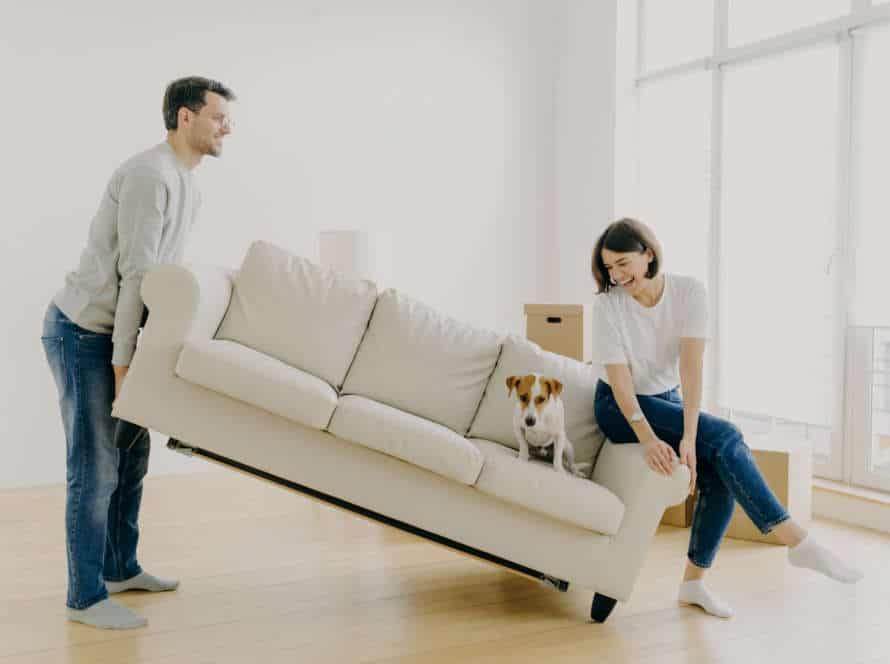How to Differentiate Separation Anxiety from Boredom
Separation anxiety and boredom in dogs can look similar. But there are differences that let us tell them apart.
Separation anxiety is more intense and happens when the dog’s owner isn’t around. Signs include destructive chewing, excessive barking and trying to escape.
Boredom-related behaviors are milder. Such as chewing on shoes or furniture, pacing or restlessness, and grooming too much.
Sometimes dogs show both. Observe your dog’s behavior and see which one it is.
Pro tip: Give your dog mental and physical stimulation before you leave them. This helps with both separation anxiety and boredom.
Understanding Separation Anxiety
Animals may experience separation anxiety when apart from their owners. It can be distressing and cause serious behavior problems. To learn how to spot it, let’s look closer at the signs and symptoms. Is your pet simply bored or do they suffer from separation anxiety?
What is Separation Anxiety?
Separation anxiety is a psychological condition that affects many dogs. It’s characterized by stress, anxiety, or destructive behavior when their owner or primary caregiver is not present.
Here are some of the signs that show it’s separation anxiety and not boredom:
- Agitation or distress when left alone.
- Trying to follow their owner to the door or escape the house/crate.
- Breaking things in the house – doors, windows, etc.
- Vocalizing – howling or barking too much.
- Self-harm – chewing/scratching their body or objects nearby.
It can be hard to tell the difference between separation anxiety and boredom. To treat it properly, it’s best to get help from a professional vet or dog behaviorist.
Symptoms of Separation Anxiety
Separation anxiety can cause great strife for both doggie and owner. It’s key to spot the symptoms. These are some that may show up:
- Whining, barking, howling when alone.
- Trying to escape the house or kennel.
- Chewing, digging destructively.
- Peeing or pooping in the house.
- Pacing or being restless.
- Loss of appetite or drooling.
It’s important to know the diff between separation anxiety and boredom. Separation anxiety needs more structure and might need a pro’s help.
Pro tip: Slowly introduce your dog to being by itself. Give them mental and physical stimulation while away. This can help lessen the symptoms of separation anxiety over time.
Causes of Separation Anxiety
Separation anxiety is caused by various factors that lead to a dog’s stress when alone. Causes can include:
- Not enough socialization or limited contact with people and other dogs.
- A change in environment, like moving home or someone being away.
- A traumatic experience like abandonment or a disaster.
- Genes – some breeds are more prone to separation anxiety.
To tell if it’s separation anxiety or boredom, look for signs like barking, destructive behaviour and escape attempts. If your dog only does these when you leave, it may be suffering from separation anxiety.
Understanding Boredom in Dogs
Dogs have an innate interest and need for mental and physical activity. If these needs aren’t met, they can get bored and act out. So, it’s important to know the signs of a bored pup. These clues can be mistaken for separation anxiety. We’ll explain how to tell these apart and give ideas to help.
What is Boredom in Dogs?
Boredom in dogs is a state of boredom, restlessness and frustration. It’s due to lack of activity or mental stimulation. It can cause bad behaviors, like chewing, digging, and barking.
Here are some signs that show the difference between boredom and separation anxiety:
- Boredom Signs:
- – Pacing around the house,
- – Destructive behavior,
- – Attention-seeking behavior.
- Separation Anxiety Signs:
- – Excessive barking or howling,
- – Destructive or self-injurious behavior,
- – Toileting accidents.
To prevent boredom in dogs, regular exercise and mental stimulation, like walks, puzzle toys, and interactive games, help. If your dog has signs of separation anxiety, get guidance from a vet behaviorist to make a treatment plan.
Symptoms of Boredom in Dogs
Is your pup feeling down? Boredom in dogs may present itself in many ways. These include:
- Chewing or gnawing on belongings.
- Digging up the garden.
- Excessive barking, whining, or howling.
- Obsessive licking or chewing on body parts.
- Restlessness and pacing.
- Seeking attention and playtime when owners are home.
If your pooch is exhibiting these symptoms, it may be boredom. But, if they’re drooling, being destructive only when you’re not around, and trying to escape, they may have separation anxiety. This requires different treatment than just boredom.
Causes of Boredom in Dogs
Dogs may get bored for several reasons. It is important to know what causes it and how to tell it apart from separation anxiety.
- Exercise: Dogs with lots of energy need exercise to expend their energy. No exercise can lead to boredom and bad behaviour.
- Monotony: Doing the same thing can bore dogs. Switching up toys, playing new games, and training can help.
- Socialization: Dogs need people and other dogs to stay mentally active.
- Separation Anxiety: This is often mistaken as boredom. It can cause destructive behaviour and barking when you are away. Knowing the difference between them can help manage their behaviour.
How to Differentiate Separation Anxiety from Boredom
Differentiating between separation anxiety and boredom in dogs can be tricky. To know the source of your pup’s actions, it is key to recognize the symptoms. Separation anxiety may lead to chewing, barking too much, and digging. Boredom might cause restlessness, being too active, and having a tough time concentrating. It is important to distinguish between the two and make a tailored plan to deal with each one.
Observe Your Dog’s Behavior
Observing your pup’s conduct is vital to tell apart separation anxiety from boredom. Here are some clues:
- Separation Anxiety: If your dog gets nervous, behaves badly, or loses it when you leave home/room, it might be a symptom of separation anxiety. Plus, excessive yapping or whining, inappropriate peeing/pooing, and self-harm.
- Boredom: If your dog appears uninterested or listless when you’re around or does damaging things when alone, they may be bored. Also, too much snoozing and lack of interest for strolls or playtime.
If you’re still confused, chat with your vet or a qualified dog behaviorist to get the correct diagnosis and treatment plan made for your doggo.
Analyze Your Dog’s Environment
It’s essential to analyze your pup’s environment to spot the difference between separation anxiety and boredom. These are both common reasons for destructive behavior when dogs are left alone.
Separation Anxiety Signs:
- Anxious/panicked when left alone – even for a little while.
- Follows you around the house and gets restless when you’re about to leave.
- Becomes vocal/destructive when you leave (whimpering, barking, digging, scratching).
- Shaky, panting, or low activity levels when distressed.
Boredom Signs:
- Chewing or digging destructively.
- Barking/whining a lot.
- Pacing/spinning restlessly.
- Reduced appetite/no interest in treats or toys.
By understanding the signs of both separation anxiety and boredom, you can take steps to ease your pup’s distress and stop destructive behavior.
Rule Out Medical Conditions
Eliminate medical conditions to distinguish if your dog’s behavior is from separation anxiety or boredom. Like humans, dogs can feel anxious or stressed from a variety of causes.
To identify the issue, see a vet to rule out any medical problems that may be causing distress.
Separation anxiety can show as destructive behavior, vocalization, or physical issues such as vomiting, diarrhea, or lack of appetite when away from the owner.
In contrast, boredom can lead to destruction or loud barking without symptoms like vomiting or lack of appetite.
Once medical conditions are ruled out, start addressing the issue with training exercises or get a professional dog trainer’s help.
Tip: Always seek professional guidance before making any assumptions about a dog’s mental condition.
Prevention Strategies for Separation Anxiety and Boredom
Separation anxiety and boredom are common in dogs. This can cause several behavioral issues. Separation anxiety occurs when a pup fears being away from their human. Boredom is caused by a lack of mental stimulation. Luckily, these problems can be stopped! Here are strategies to tackle them:
Enrich Your Dog’s Environment
Enriching your pup’s environment can help avoid separation anxiety and tedium. It’s essential to understand the difference between these two to handle them properly. Separation anxiety is a fear of being alone. Dogs may show it by destructive behavior, incessant barking, and house soiling. On the contrary, boredom is due to a lack of mental stimulation. Pups may express it through destructive behavior, excessive barking, and digging.
To prevent both boredom and separation anxiety, here are a few tips:
- Provide interactive toys like puzzle feeders and treat-dispensing toys.
- Vary the toys to keep your pup engaged.
- Offer physical exercise and mental stimulation through games such as hide-and-seek and scent work.
- Teach your pup obedience and tricks. This helps with mental stimulation and strengthens your bond.
- Create a safe space for your pup when they are feeling overwhelmed.
- Lastly, if your pup’s anxiety or boredom persists, seek professional help.
Slowly Acclimate Your Dog to Being Alone
If your pup is battling with separation anxiety or boredom, slowly getting them used to being on their own can be an efficient prevention tactic. But, it’s essential to recognize the differences between separation anxiety and boredom before beginning any avoidance strategies.
Separation anxiety is seen through too much barking, ruining stuff, and other indications of distress when unsupervised. On the flip side, when owners are around but not interacting, boredom may appear as destructive behavior and too much energy.
Here’s what to do to acclimatize your pup to being alone:
- Begin with short amounts of time away and gradually lengthen it.
- Supply your pup with playthings and chew treats to keep them entertained.
- Designate a space for your pup to escape to when they feel anxious or bored.
- Set up a schedule and stay consistent with it, as predictability can help reduce anxiety.
Think about recruiting a professional trainer or behaviorist if your pup’s separation anxiety or boredom is serious.
Provide Adequate Exercise and Mental Stimulation
To prevent separation anxiety and boredom in dogs, adequate exercise and mental stimulation are key. Separation anxiety is fear or distress when alone. Boredom is caused by lack of activity and stimulation. Here are tips to differentiate and prevent them:
For separation anxiety:
- Gradually increase alone time.
- Give a comfy retreat with toys and treats.
- Make a routine for leaving and arriving.
- Consult a professional if necessary.
For boredom:
- Provide exercise, like walks.
- Stimulate the mind with interactive toys and feeders.
- Teach new tricks and commands.
- Give enough social interaction and playtime.
Pro Tip: Recognizing the difference is important for caring for pets. Exercise and mental stimulation can reduce the risk of these conditions.
Treatment Strategies for Separation Anxiety
Separation anxiety in dogs is much more intense than being bored. The cause of this distress is usually something that the pup fears, such as a loud sound. To cure this, it’s important to know what is bringing on the anxiety. After you discover the source, there are several treatment methods which can help the pup manage it better.
Desensitization and Counterconditioning
Desensitization and counterconditioning are two efficient treatments for dogs with separation anxiety. Desensitization involves presenting the pup to triggers causing anxiety slowly. Counterconditioning means replacing the bad connection with a positive one.
To do desensitization, start by leaving your pup for short intervals near them. Increase the time as they become more relaxed. Counterconditioning is done by giving them a special treat or toy only when alone – creating a good link with you not being there.
It is vital to differentiate separation anxiety from boredom. Signs of separation anxiety are: destructiveness, barking/whining, and trying to escape. If your pup is bored, providing exercise and stimulation can help.
Pro tip: If you think your pup has separation anxiety, consult with a trainer or vet to setup a plan.
Medication
Medications can help with separation anxiety in dogs – but it’s important to differentiate between this and boredom.
Separation anxiety is serious, causing distress, which leads to destructive behaviors, vocalizing, and physical symptoms. Boredom, however, has different causes.
Look for distress signs only when you’re not around, like panting, pacing, and chewing. To combat boredom, give your pup plenty of toys and interactive games. If your dog has separation anxiety, anti-anxiety drugs and antidepressants can help along with behavior modification. Your vet is the best source for advice.
Pro-tip: Medications should only be used with a vet’s guidance – never as a standalone treatment.
Seeking Professional Help
Suspect your pet has separation anxiety? Professional help from a vet or animal behaviorist is advised. Here’s why:
- Only an expert can properly diagnose if destructive behavior is due to separation anxiety or boredom.
- Expert can provide personalized treatment options to address the cause of pet’s anxiety, not just treat symptoms.
- Professional help can give you and your pet more confidence and support in the treatment process.
Separation anxiety can be hard to solve, but with the right help and strategies it’s possible to have a better relationship with your furry friend.
Treatment Strategies for Boredom in Dogs
Dogs can suffer from boredom. This can show as barking too much, digging, and destructive actions. Treating boredom in dogs is unlike treating separation anxiety. To handle the problem, firstly know the difference between separation anxiety and boredom. This is vital for finding the right treatment for your pup.
Provide Interactive Toys and Puzzles
Interactive toys and puzzles can help bored dogs. They can also tell if a dog has boredom or separation anxiety. Kong toys are great for chewing and can be filled with treats. Puzzle feeders will keep them occupied longer. Bob-a-lots move unpredictably and treat-dispensing balls release treats.
To tell if it’s boredom or loneliness, observe their behavior. If they are destructive when left alone, it’s likely separation anxiety. Boredom may show as too much energy, lack of interest in toys, and restless behavior.
One tip: Regular walks and playtime can help with boredom and anxiety.
Engage Your Dog in Training and Playtime
To reduce boredom and distress in dogs, engage them in training and playtime. Differentiating between boredom and separation anxiety in dogs can be tricky. Here are some tips:
- Behaviors: A bored pup might chew stuff or bark, while one with separation anxiety could howl or chew furniture to escape.
- Timing: Boredom can happen anytime, but separation anxiety is mostly when the pup is alone or away from their owner.
- Response to owner: A bored dog may seem uninterested when you come back, but one with anxiety might jump and bark a lot.
To give stimulation and reduce boredom, train, play games like fetch and socialize with other dogs. Pro Tip- Keep the sessions short to stop exhaustion and frustration.
Hire a Dog Walker or Sitter
Hiring a dog walker or sitter is a great way to battle boredom in canines. But, it’s essential to tell the difference between boredom and separation anxiety for an effective treatment.
Boredom behaviors, such as destructive chewing, excessive barking, digging, and pacing, happen when the owner is away or the pup is left alone for a long time.
In this case, bringing in a dog walker or sitter can help break the monotony and give the pup the mental stimulation it requires.
Separation anxiety, however, is a serious psychological issue and needs professional help. Its symptoms include severe distress when left alone, destructive behavior, too much barking or howling, and inappropriate elimination.
For this, consulting a certified dog behaviorist to create a comprehensive treatment plan is key.
It’s important to differentiate between boredom and separation anxiety to provide the appropriate treatment strategy for the canine’s emotional wellbeing.
Conclusion
To wrap it up, telling separation anxiety and boredom apart in dogs needs close watching and understanding of their actions.
Signs of separation anxiety could be barking, destructive habits, and peeing or pooping somewhere it shouldn’t.
Dogs with boredom may show restlessness, chew a lot and dig.
Knowing your dog’s routine, offering enrichment activities, and slowly increasing the length of time left alone can help with both separation anxiety and boredom.
Getting advice from a vet or animal behaviorist can give extra support and direction for dealing with these regular problems.
Frequently Asked Questions
1. How can I tell if my dog is experiencing separation anxiety or just bored?
The key difference is in the behavior your dog displays. If your dog appears anxious or distressed when you leave, and engages in destructive or self-harming behaviors, it may be a sign of separation anxiety. Boredom, on the other hand, may lead to less destructive behaviors such as pacing, whining or barking, and general restlessness.
2. Can separation anxiety develop over time or is it something my dog is born with?
Separation anxiety can develop over time as a result of a change in routine, a major life event, or a traumatic experience. It is not necessarily something your dog is born with, but rather a behavioral issue that can arise due to environmental or situational factors.
3. How can I help my dog cope with separation anxiety?
There are several strategies you can try to help your dog cope with separation anxiety, including gradually increasing separation time, providing toys or puzzles to keep your dog occupied, and practicing positive reinforcement techniques. You may also want to consult with a professional dog trainer or behaviorist for additional guidance and support.
4. Are there any medications that can help with separation anxiety?
Antidepressants and anti-anxiety medications may be prescribed by a veterinarian to help manage the symptoms of separation anxiety, however, medication should not be used as a sole treatment and should always be used in conjunction with behavioral training and environmental modifications.
5. How long does it take to see results from separation anxiety treatment?
The length of time it takes to see results from separation anxiety treatment can vary depending on a number of factors, including the severity of your dog’s symptoms and how consistently you are implementing the treatment plan. However, with patience and persistence, you should see gradual improvement in your dog’s behavior over time.
6. Can boredom lead to separation anxiety?
Boredom can contribute to separation anxiety, especially if your dog is left alone for extended periods of time without any stimulation or engagement. It is important to provide your dog with regular exercise, mental stimulation, and socialization opportunities to help prevent boredom and related behavioral issues.







